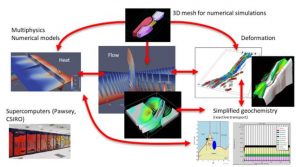|


Fri, Aug 21, 2020
1 pm AWST (Perth Time)
Mineral systems involve complex interactions between deformation, fluid flow, heat transport and chemical reactions. In order for geologists to test the influence of these processes and their interactions through “what if” scenarios, efficient simulation tools are particularly useful. In many systems understanding fluid flow is critical to the conceptual understanding of the system and advancing our predictive capabilities. In our presentation we show how numerical simulations of hydrothermal mineral systems provide an important tool for improving our understanding of fluid flow and other key processes that operate in mineral systems, and for predicting the signatures and/or locations of hydrothermal mineral deposits.
To do this we use numerical simulation at both ends of the hypothesis testing spectrum to cover: (1) conceptual models to explore fundamental aspects of poorly-understood processes such as fluid flow through fault systems, or episodicity and periodicity related to deformation, and (2) simulations incorporating multiple components (e.g. complex geological architecture, multi-physics, temperature- and pressure-dependent material properties, heterogeneous material property distributions) but with simplified underlying physics. In this way we may account for a detailed understanding of a single phenomenon in some models, or for more complex process interactions involving several phenomena in other models.
Dr Peter Schaubs completed his PhD at the University of Melbourne, has been at CSIRO since 1999 and currently leads the Structural Geology and Modelling Team. His primary scientific driver is to progress our understanding of the effects of deformation on the formation of hydrothermal ore-deposits in order to reduce both the time and costs associated with exploring for these deposits. In order to achieve this he uses a combination of structural geology, 3D model building, and expertise in numerical modelling.
Dr Heather Sheldon completed a PhD on “Numerical modelling of reactive fluid flow and deformation in geological systems” at Liverpool University (UK) in 2003. Since then she has been a research scientist at CSIRO, where she has been involved in the development and application of numerical modelling tools for mineral exploration and geothermal systems. A particular focus in recent years has been on transferring desktop computer-based workflows into tools that can be run on supercomputers. The new supercomputing workflow is now well-established, and has produced results that are providing insights into mineralisation in the Northern Territory.
Dr Thomas Poulet graduated in applied mathematics from the Ecole Polytechnique (France) in 2000, from the Ecole Nationale Superieure des Telecommunications (Paris) in 2002 and obtained his PhD from UWA (Perth) in 2012. He joined CSIRO in 2003 and has been a team leader since 2007. His areas of expertise include numerical modelling, signal processing, mathematical optimisation and visualisation of high dimensional model parameters, software engineering, e-Research, grid services and high performance computing. His research activities centre on reactive transport in porous media and thermodynamics of dissipative processes.
when joining please turn off your video and mute your microphone. There’ll be a chance to ask questions via the chat window.
You can join this CSIRO Webex conference from Desktop or Mobile Devices: